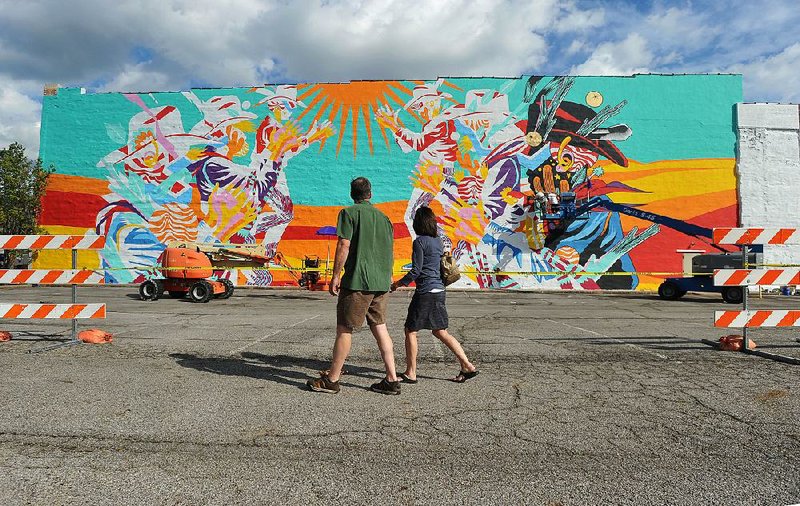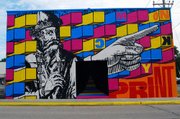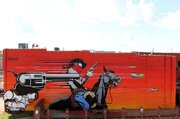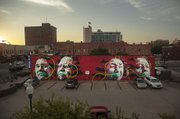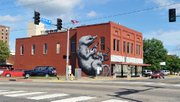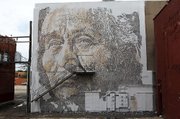FORT SMITH -- Northwest Arkansas has once again captured the attention of the international art community.
This time, however, the buzz does not come from the activities and high-profile acquisitions of Bentonville's Crystal Bridges Museum of American Art or Fayetteville's Walton Arts Center.
Fort Smith's downtown has captured the attention of contemporary art lovers with 10 huge, colorful murals by internationally known street artists that adorn exterior walls of buildings, mostly along Garrison Avenue, in the city's historic downtown. Another mural was designed by University of Arkansas at Fort Smith faculty member Bryan Alexis and painted by UAFS students.
The murals have generated the interest of art publications such as Arrested Motion, Complex, Hypebeast and Highsnobiety.
"Arkansas has become a destination for the arts with the Crystal Bridges, Walton Arts Center and the Arkansas Arts Center," says Claire Kolberg, director of events for 64.6 Downtown, a nonprofit organization founded by Fort Smith businessman Steve Clark.
"We wanted to capture some of that space without duplicating what those establishments were already doing," she says.
"We have added another reason for people to come to Arkansas and engage with the arts."
It may come as a surprise to many that murals -- street art -- would find a home in Fort Smith, but it's all part of the vision of 64.6 Downtown, which has worked to find a unique attraction that would support activities to revitalize downtown and bring a renewed vibrancy to the riverfront and the city.
The organization's name is taken from the city's land size -- 64.6 square miles.
The group played up the unexpected nature of their endeavor by revealing the murals at a festival -- appropriately titled The Unexpected -- from Sept. 4-12.
So how did the unexpected happen?
The vision began to take shape in fall 2014. Clark, founder and chief executive officer of Propak Logistics; John McIntosh, 64.6 Downtown executive director, and Kolberg held meetings and made plans to fulfill the vision.
The group believed downtown's revitalization could be enhanced through an appropriate arts medium.
"Street art is accessible to everyone and we felt it would be a perfect fit in Fort Smith, where people can experience a painted mural on their own, without barriers separating them from the art," Kolberg says.
So, while the mission was defined, the group was uncertain about the processes required to accomplish it; 64.6 Downtown's leaders realized they would need an adviser to execute the project. Clark had cultivated a relationship with renowned Irish street artist Maser during a previous Northwest Arkansas project, so Clark approached him for advice on 64.6's plan.
Maser recommended the organization enlist the help of a professional art curator. The artist had recently completed a project through the art network JustKids, working with French art curator Charlotte Dutoit. He recommended Clark talk to her.
So, Clark and 64.6 invited Dutoit to Fort Smith.
Dutoit was very positive and enthusiastic about the project; 64.6 Downtown hired her to help curate The Unexpected, a festival of the arts.
Dutoit brought more than enthusiasm to the project; she brought her reputation. Dutoit is the founder and curator for Life Is Beautiful Music and Art Festival in Las Vegas, the largest street art event in the United States. Her affiliation with The Unexpected gave the new event instant credibility and access to internationally known street artists.
During the festival's September debut, artists from Ireland, Portugal, United Kingdom, Belgium, Puerto Rico and Brazil, along with UAFS students, gathered to create art on the exterior walls of buildings within a 10-block district.
Kolberg and the 64.6 Downtown team are now focused on encouraging visitors to become engaged with these very original works of art. So far, the art has generated more than 3 million hits on 64.6's social network, along with many posted comments.
"Whether the conversation is someone saying they love that painting or they hate this one, that is what street art is all about," Kolberg says, "to inspire viewers to engage in that conversation about the works of art."
A free walking tour is available; information and a map are available at 646downtown.com.
Here's what you'll see on a walking tour of The Unexpected:
• Badlands by English multimedia street artist DFace. A leading figure at the forefront of the urban art movement for well over a decade, DFace was inspired by the outlaws and the U.S. Marshals Service of Fort Smith's past. Using his trademark pop-art style, D*Face has captured the fast-paced, thrilling excitement of the chase scene of the Western era.
• Untitled is the work of New Zealand's best known graffiti writer, Askew. The artist has been recognized for his colorful images of indigenous people. Askew featured four family members of Cherokee Chief Joe Byrd on his wall. It is best to view the painting from afar and intimately close, to appreciate the depth of character Askew has captured in his subjects' portraits.
• The Mole by Belgian artist ROA. Known for painting rodents that are native to the area in which he is painting, ROA raises the common mole to new levels in his first of two murals. His philosophy is that, "If he doesn't give the mole his moment in the sun, then who will?" Pause to appreciate the life he has given the mammal using only shades of black and white.
• Catira by Brazilian design and illustration collective Bicicleta Sem Freio. Incorporating vibrant and electric colors, the group pays tribute to Fort Smith's Western history with a portrait of catira, the traditional western dance from Brazil. While viewing the festive celebration of the ranchers and farmers, one can almost hear the stomping, clapping and whooping of the dancers.
• The Otter by ROA. In his second mural, ROA remains true to his reputation of showcasing urban wildlife. This time, he gives the otter his day in the sun. Known for their adaptability, this playful weasel has already made himself comfortable in his new setting.
• Untitled by Puerto Rico-born artist Ana Maria. "In my imagination," Maria says on The Unexpected's website, 646downtown.com, "different dimensions of life and time collide to create characters with mixed phenotypes, animal, mechanical and human, functioning parallel to a story that I feel every second I spend on the process but only the spectator can tell."
• Untitled by Maser. When Maser came to Fort Smith, he was inspired by the city being the birthplace of William Orlando Darby of Darby's Rangers fame. Sensing a connection with the military commander whose unit first trained in Maser's homeland of Northern Ireland, he wanted to pay homage to Fort Smith's famous native son with a big wall mural featuring the elite commando unit in action. Eventually the unit evolved into the present-day Army Rangers.
• Untitled by Portuguese street artist Vhils. Viewed from a distance, the mural has the accuracy and detail of a photograph. However, when you approach the piece, you truly appreciate the artist's unique talent and creativity. Using jackhammers and chisels, yet possessing the delicate touch of a surgeon, Vhils carves images directly into the walls. This iconic image is based on the first photographs made of Cherokee Indians.
• Untitled by Ana Maria. "I want to play with the act of abstinence in my work, creating beasts that can deprive life at the minimal or [nonexistent] provocation, but they choose to stay still, they choose peace," Maria writes in an artist's statement posted at behance.net.
• Untitled is designed by UAFS faculty member Alexis and painted by the students. This exhibit creates a colorful interpretive blend of the old and new of the print world. The image of Johannes Gutenberg, inventor of movable-type printing, represents the past; the backdrop of colorful whizzing boxes is reminiscent of the digital age, with the imposing hand optimistically pointing up to the future. Ominously located in the center, a 3-D stairway leads into the dark unknown.
• Trail of Tears by DFace. In this simple yet striking image, DFace captures the pain and sorrow of the Cherokee Nation on its march across Arkansas to what is now Oklahoma. The symbolism of the arrow piercing a bull's-eye within a heart speaks loudly; its message is open to one's own interpretation.
Style on 11/15/2015
